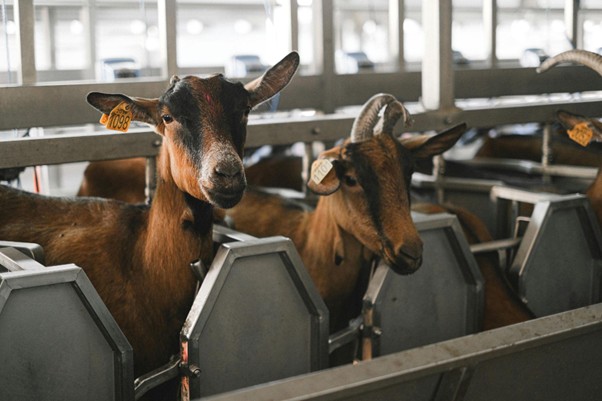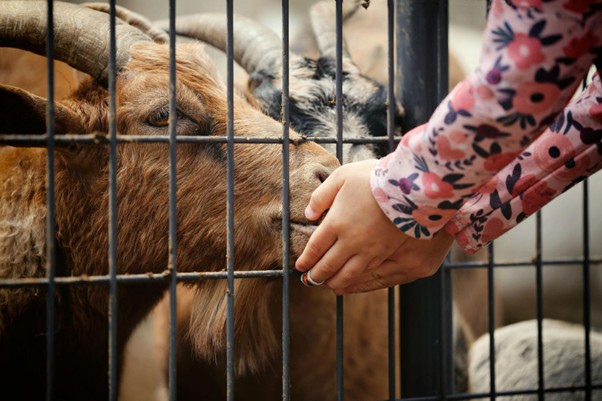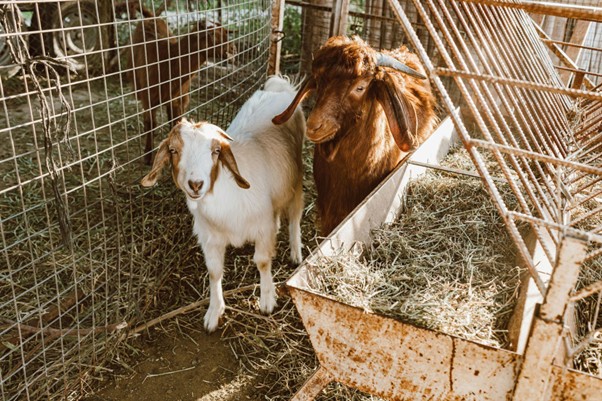Common Parasites in Goats: How to Maintain a Healthy Herd

Goat parasites are extremely harmful; they lead to several health issues like weight loss, diarrhea, anemia, stunted growth, infertility, and bottle jaw. The economic impact of parasites is equally severe; their presence can reduce meat/milk production, diminish reproduction success, increase treatment costs, and increase mortality.
Efficient parasite management is essential to maintain herd health, improve productivity, and ensure the long-term sustainability of goat farming.
Common Parasites in Goats

Goats are vulnerable to both external and internal parasites, which can affect their health, productivity, and overall performance. External parasites live on the skin, feeding on blood and tissue, while internal parasites inhabit organs such as the stomach, intestines, and liver. Understanding common parasites, their active seasons, high-risk periods, and transmission routes is key to effective control.
External Parasites in Goats
Common external parasites include lice, mites, and ticks. These parasites irritate the goat's skin, cause discomfort, and can lead to serious disease if left untreated.
Lice
Lice are small, wingless insects that feed on the skin and blood of goats, causing irritation and stress.
- Symptoms: Itching, hair loss, scabs, restlessness, and poor coat condition.
- Season: Most active in late fall to early spring, especially in cooler weather.
- High-Risk Periods: During winter or when goats are housed closely together.
- Transmission: Spread through direct contact between animals or contaminated brushes, feeders, and equipment.
Mites
Mites are tiny arachnids that burrow into the skin or live on its surface, leading to mange and severe itching.
- Symptoms: Hair loss, thickened or scaly skin, scabs, and intense scratching
- Season: Active during colder months.
- High-Risk Periods: Winter and periods of poor hygiene or overcrowding.
- Transmission: Direct contact with infected animals or contaminated bedding and housing.
Ticks
Ticks attach to the goat's skin and feed on blood. They may transmit diseases such as anaplasmosis and babesiosis.
- Symptoms: Anemia, skin irritation, scabs, weight loss, and restlessness.
- Season: Most active in warm, humid months (spring through late summer)
- High-Risk Periods: During grazing in tick-infested pastures or brushy areas.
- Transmission: From infested vegetation or through direct contact.
Internal Parasites in Goats
Common internal parasites include barber's pole worm, tapeworms, liver flukes, and coccidia. These parasites primarily affect the digestive system, nutrient absorption, and immunity.
Barber's Pole Worm
A blood-sucking worm found in the stomach that causes severe anemia and weakness.
- Symptoms: Pale eyelids and gums, bottle jaw (fluid under the jaw), weight loss, and lethargy.
- Season: Most active in warm, wet seasons.
- High-Risk Periods: Late spring to early fall when pastures are moist.
- Transmission: Ingestion of larvae from contaminated pasture or feed.
Coccidia
Microscopic protozoa that infect the intestinal lining, especially in young goats.
- Symptoms: Diarrhea (sometimes bloody), dehydration, poor growth, and rough coat.
- Season: Thrive in warm, damp environments.
- High-Risk Periods: During weaning and stress periods; most common in crowded pens.
- Transmission: Ingestion of oocysts from contaminated feed, water, or bedding.
Liver Fluke
Liver flukes are flatworms that infect the liver and bile ducts. They cause tissue damage and impair liver function.
- Symptoms: Weight loss, anemia, lethargy, bottle jaw, reduced appetite.
- Season: Most common in wet or marshy grazing areas.
- High-Risk Periods: Late summer to fall in areas with standing water or snails.
- Transmission: Ingestion of infective cysts (metacercariae) on contaminated grass; requires snails as intermediate hosts.
Lungworms
Parasitic worms that inhabit the lungs and lay eggs to cause respiratory distress.
- Symptoms: Persistent coughing, nasal discharge, difficulty breathing, and weight loss.
- Season: More common in cool, moist conditions.
- High-Risk Periods: During extended wet weather or overcrowded housing.
- Transmission: Ingestion of larvae from contaminated pasture or feed.
Brown Stomach Worm
A stomach worm that interferes with digestion and nutrient absorption.
- Symptoms: Diarrhea, loss of appetite, weight loss, dull coat.
- Season: Active during cool, wet seasons.
- High-Risk Periods: Early spring and fall.
- Transmission: Ingestion of larvae from contaminated pastures.
Tapeworms
Flat intestinal worms that absorb nutrients, often affecting growth in young goats.
- Symptoms: Weight loss, pot-bellied appearance, digestive upset, visible worm segments in feces.
- Season: Year-round, depending on intermediate host presence.
- High-Risk Periods: During grazing, when intermediate hosts (like mites) are abundant.
- Transmission: Ingestion of intermediate hosts carrying tapeworm larvae.
Bankrupt Worms
Small intestinal worms that cause severe digestive disturbances and rapid weight loss.
- Symptoms: Dark, watery diarrhea, weakness, stunted growth, and a rough coat.
- Season: Active during cool, moist seasons.
- High-Risk Periods: Spring and fall; more common in overgrazed or damp pastures.
- Transmission: Ingestion of larvae from contaminated grass or soil.
Symptoms of Parasites Affect Your Goats

Each parasite affects goats differently, and distinct signs can help farmers identify these infections early so they can take prompt action for treatment and recovery. The table below summarizes common symptoms of parasites and their effects for quick reference.
Risk Periods for Parasite Infestations in Goats

Certain periods and conditions make goats more vulnerable to parasite infestations. Recognizing these high-risk situations helps farmers take preventive measures and protect the herd's health.
Young Goats (Kids)
Young goats have developing immune systems, which make them highly susceptible to internal parasites like coccidia and stomach worms.
Pregnant/Lactating Goats
Pregnant goats and lactating does experience higher stress and nutritional demands, which can lower immunity and increase parasite loads.
High-Density Herds
Goats kept in crowded pens or pastures are more prone to parasite spread through direct contact or contaminated feed and bedding.
Wet, Warm Seasons
Parasites thrive in warm and humid conditions, which makes monsoon or rainy seasons particularly high-risk for outbreaks.
Overgrazed or Short Pastures
Overgrazed pastures force goats to graze closer to the ground, where parasite eggs and larvae are most concentrated.
Introducing New Goats
Newly purchased or relocated goats can carry parasites that spread if the animals are not quarantined or dewormed before joining the herd.
Complications from Parasite Infections in Goats
Parasite infections can lead to a range of health and productivity issues in goats. The severity often depends on the animal's age and overall condition, with young and older goats being the most vulnerable.
Effects on Young Goats
Kids are especially prone to parasite-related complications because their immune systems are still developing. Infestations can result in:
- Poor growth and weight gain
- Diarrhea and dehydration
- Weakness and lethargy
- Anemia and bottle jaw
- Higher risk of secondary infections
- If left untreated, severe infestations in young goats can be fatal.
Effects on Adult and Older Goats
In mature or older goats, parasite infections may not always be life-threatening but can cause long-term performance losses. Common complications include:
- Reduced milk output in lactating does
- Poor reproductive performance
- Weight loss and reduced body condition
- Lower immunity and increased disease susceptibility
How to Control Parasites in Goats

Effective parasite control in goats requires a mix of preventive management, regular monitoring, and targeted treatments. By combining internal, external, and general control practices, farmers can maintain healthy herds and minimize productivity losses.
Internal Parasite Control in Goats
- Regular Deworming: Use anthelmintics based on fecal egg counts and veterinary advice to avoid resistance.
- Rotational Grazing: Move goats between pastures to break the parasite life cycle and reduce larval buildup.
- Proper Nutrition: Provide balanced diets to strengthen immunity and help goats resist internal infections.
- Fecal Testing: Monitor worm burdens regularly to identify infestations early and apply selective treatment.
- Avoid Overcrowding: Reduce the spread of larvae through contaminated feces by managing herd density.
- Targeted Deworming: Focus on high-risk animals such as kids, lactating does, or goats showing signs of weakness.
External Parasite Control in Goats
- Regular Inspection: Check for lice, mites, and ticks, especially around ears, tail, and underbelly.
- Topical Treatments: Use approved sprays, dips, or pour-ons to control external parasites.
- Clean Housing: Keep shelters dry, well-ventilated, and regularly disinfected to reduce parasite habitats.
- Pasture Maintenance: Mow tall grass and remove debris to limit tick hiding spots.
- Isolate Infected Goats: Separate and treat affected animals promptly to prevent spread.
- Seasonal Control: Apply external parasite treatments before peak seasons like spring and monsoon.
General Parasite Control in Goats
- Quarantine New Animals: Deworm and observe all newly introduced goats before mixing with the herd.
- Clean Feeding Practices: Avoid feeding on the ground to reduce exposure to parasite eggs and larvae.
- Manure Management: Regularly remove manure to minimize contamination and breeding sites.
- Monitor Weight and Coat Condition: Early changes can indicate rising parasite levels.
- Work with a Veterinarian: Develop a strategic parasite control plan based on local conditions and resistance trends.
Expert Suggestions for Effective Parasite Control in Goats
Successful parasite management depends on timely action, preventive care, and avoiding common management mistakes. These expert-backed tips can help farmers keep their herds healthy and productive year-round.
Best Time to Deworm Goats
- Deworm at the beginning and end of the rainy season, when parasite populations are at their peak.
- Take careful care of high-risk goats such as kids, lactating does, and goats with poor body condition.
- Rotate dewormers periodically to prevent drug resistance.
- Base treatments on fecal egg counts rather than routine schedules for more effective control.
- Deworm before moving goats to clean pastures to reduce reinfection.
Natural Remedies That Help
- Herbal supplements like neem leaves, garlic, papaya seeds, and pumpkin seeds may help reduce worm loads naturally.
- Tannin-rich forages have natural anthelmintic properties.
- Ensure a good mineral balance, such as copper and selenium, to boost immunity.
- Combine natural methods with strategic deworming and pasture rotation for the best results.
Common Mistakes Farmers Make
- Overusing dewormers, which leads to parasite resistance.
- Skipping fecal testing and relying solely on routine deworming.
- Ignoring external parasite control and focusing only on internal worms.
- Not quarantining new animals, which in turn allows parasites to spread to the herd.
- Overlooking record-keeping and not seeking timely veterinary intervention to treat the symptoms.
- Not tracking treatment effectiveness, which makes long-term control harder.
Signs That Parasite Control Is Working
When parasite control is effective, goats display bright eyes, a healthy coat, and consistent weight gain. Their energy levels improve, appetite returns to normal, and signs like diarrhea, pale eyelids, or bottle jaw disappear. Regular monitoring helps ensure the herd remains strong and resistant to reinfection.
Use FarmKeep for Goat Management
Whether you’re managing a small goat herd or a larger farm, staying organized is key to healthy, productive animals. That’s where FarmKeep, the all-in-one farm management app, comes in.
With FarmKeep, you can:
- Record health details such as deworming dates, vaccinations, weight, and vet visits.
- Monitor breeding cycles with heat tracking and foaling dates.
- Set reminders for hoof trimming, parasite control, or feed adjustments.
- Store photos and notes for quick reference during management or vet checks.
FAQs
How often should I deworm goats?
Kids should be dewormed every 2-3 weeks until they are 6 months old. Adults can be dewormed once or twice a year. If your goat is showing signs of worm infestation, deworm immediately.
How can I naturally control ticks and flies in goats?
To naturally control ticks and flies in goats, farmers must keep their shelters clean, use herbal sprays (like neem or garlic oil), maintain short pastures, and apply natural repellents during warm, humid seasons.
How can I protect a goat during pregnancy from parasites?
Deworm goats before breeding or kidding, give them good nutrition, and keep pens dry and clean to minimize exposure.
What are the common intestinal parasites in goats?
Common intestinal parasites are barber's pole worms, brown stomach worms, coccidia, tapeworms, liver flukes, and bankrupt worms.
What are the key symptoms of parasitism in goats?
The common symptoms of parasitism in goats include weight loss, rough coat, diarrhea, bottle jaw, weakness, and reduced milk output.
How do I prevent and control parasite outbreaks in goats?
To prevent and control parasites, farmers must practice rotational grazing, maintain clean housing, test feces regularly, deworm strategically, and quarantine new animals before introducing them to the herd.



